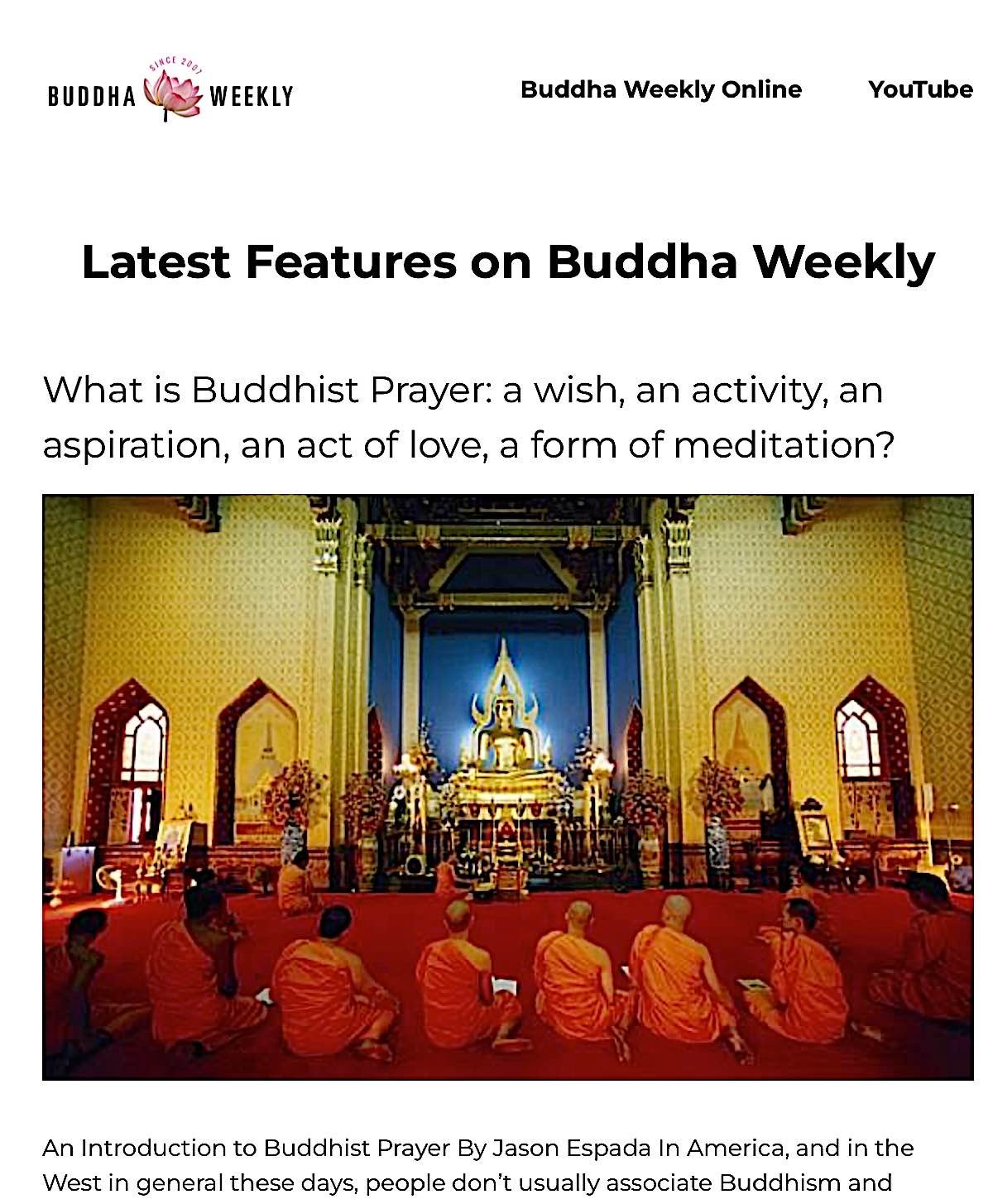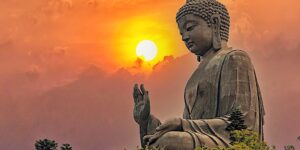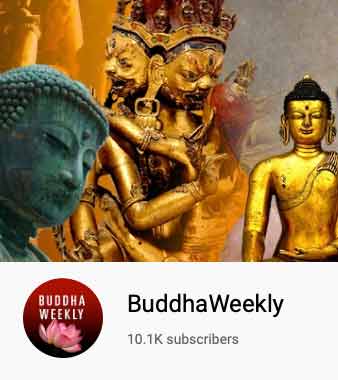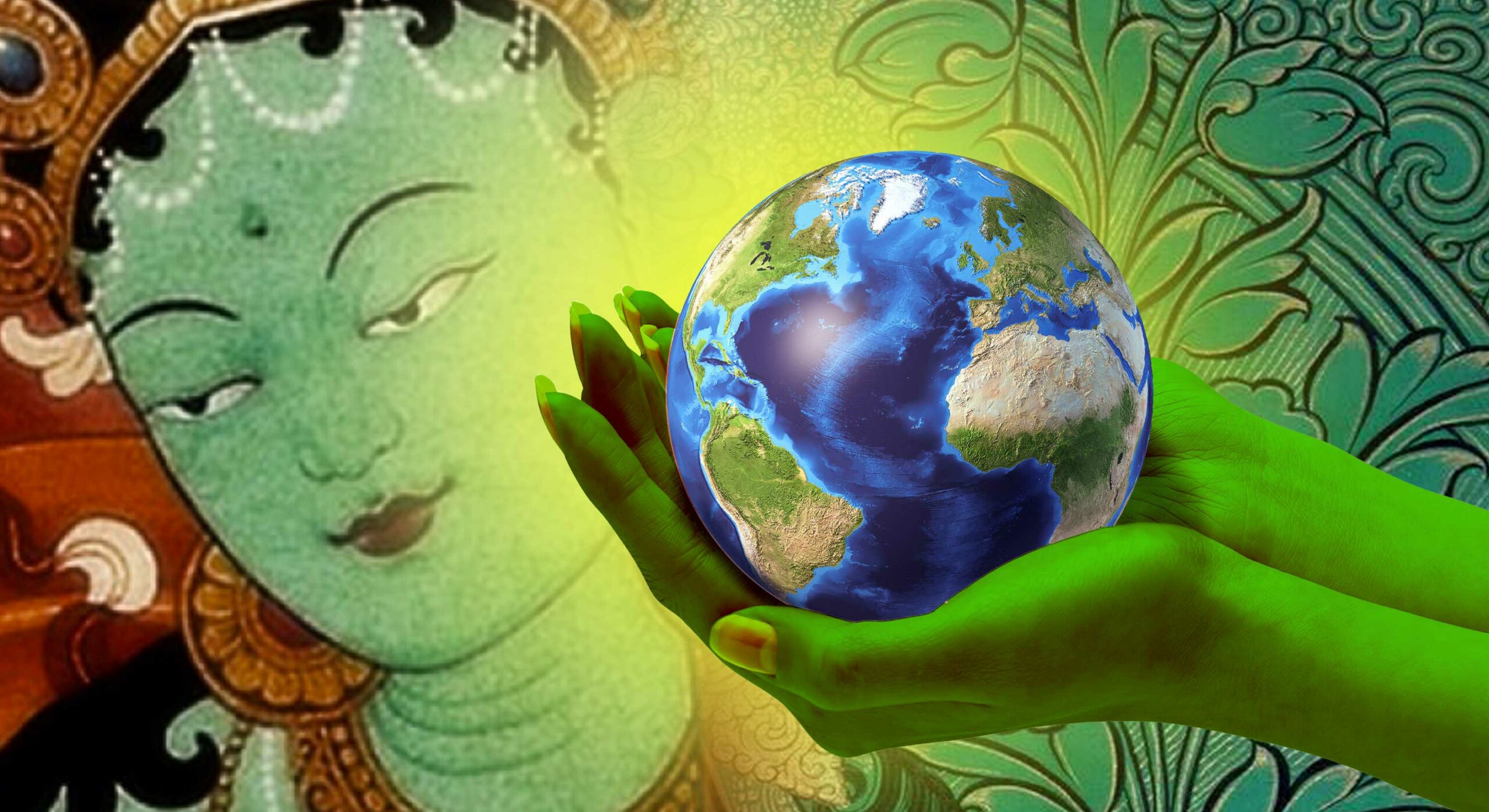Video Teaching: Amitabha Amitayus Powa teaching and guided meditation — transfering consciousness to the Pureland when dying or as a practice for “healing the mind.”
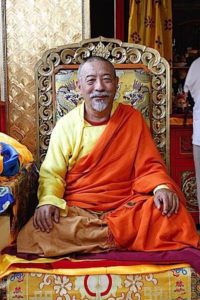
H.E. Zasep Tulku Rinpoche’s concise video commentary and guided meditation on the profound practice of Tibetan Powa — transference of our consciousness to the Pureland of Amitabha Buddha. [Full Transcript below video.]
This practice is renowned for “healing the mind” and is a higher practice that helps us overcome “fear of dying.”
NOTE: Most POWA practices are a higher tantra, and normally requires guidance (in person) from a teacher of lineage. Rinpoche indicates that — because this is Amitabha Powa — it is acceptable to practice (if one is serious) for students who need Powa practice — for example, someone who is preparing for death, has a loved one who might die, or a student who is serious about Powa practice to overcome fear of dying. In this case, a serious student, may practice this more accessible Powa of Amitabha (simplified) — without necessarily having Higher Yoga initiation. This is because this is Amitabha Powa, and Amitabha and his Pureland, are accessable practices to anyone. Rinpoche does ask students to view this as an educational video and — if practiced — to do so seriously, and preferrably under guidance of one’s teacher.
Please play video here (30 minutes):
Powa — transfering consciousness to the Pureland
Powa practice, as a regular practice, prepares us for the uncertain time when we will actually pass away, training our minds (consciousness) in how to reach the Light of Amitabha and his Pure Land.
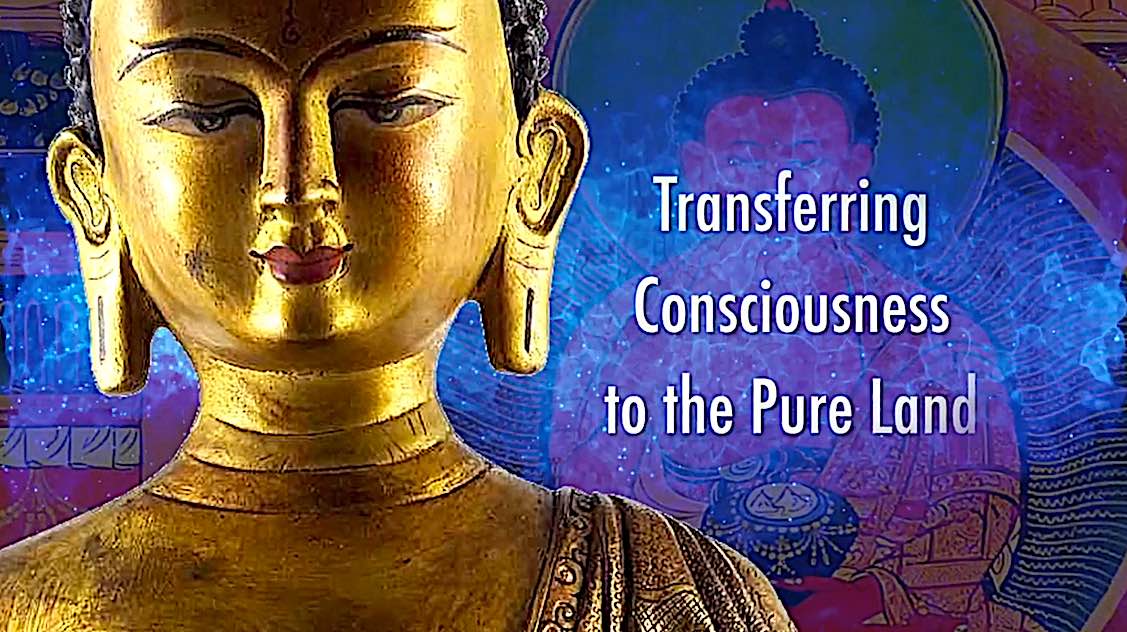
In daily practice, we visualize our consciousness going and then coming back. If one is dying, we visualize only the going, and stay in the light of Amitabha’s Pureland.
Control over one’s own death is a powerful and profound practice.
If one is “returning” — as in daily practice — Rinpoche explains how you visualize Amitabha descending to your crown, then transforming into Amitayus Buddha at your heart. Amitayus is a manifestation of Amitabha specifically for “long life” practice.
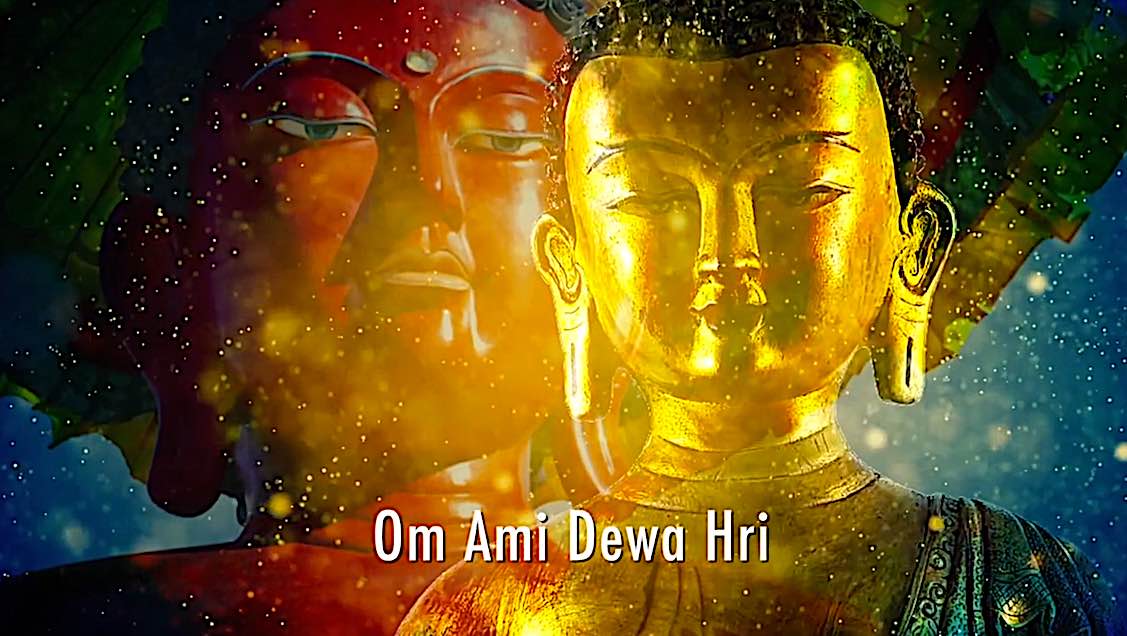
MANTRA of Amitabha:
Om Ami Dewa Hri
MANTRA of Amitayus:
OM A MA RA NI DZI WAN TI YE SOHA
The video ends with wonderful Amitabha mantra chanting by Yoko Dharma. To download her beautiful mantras, please visist yokodharma.com>>
Full Transcript
I would like to speak about Powa practice, or transferring consciousness into Buddhaland or pure realm. In Tibet Buddhist tradition, we have a wonderful practice called Powa.
This practice is for healing the mind, also overcoming fear of dying, also overcoming fear of what happens after death, or in other words after I’m gone from this world, what happens. Right? There’s big question mark for most people, I would say.
According to Tibetan Buddhist tradition, what we believe, when you’re at the end of your life, when we die, our consciousness continue from this life to the next life, or go through the Bardo, or go up to the Pureland or go to different realms, retake the reincarnation according to our karma. We now know where we are going to end up, but I guess you do know, many of you do know, because you do lots of meditation and prayers and practice, you are a good person, you have a good feeling and confidence that you are going to have a good life in the next life, like this life and you could have a good rebirth and so forth.
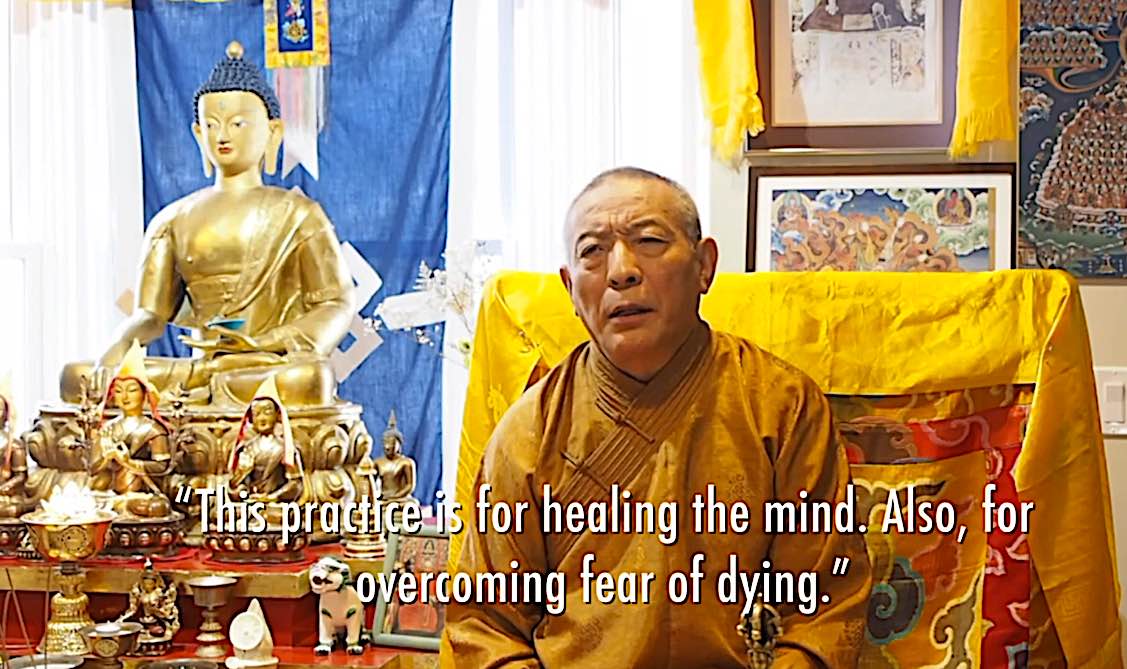
But at the same time, those of you who are serious practicing Tibetan Buddhism you would like reborn as a dharma practitioners and have a good family, child of a good family, or born in the Purelands of the Buddha, such as “Sukhavati,” the Pureland of Amitabha Buddha. We call it “Dewachen” in Tibetan word. “Dewachen” means a land of joy and peace and happiness, and a pure land.
There are many different kinds of Powa practice. “Powa means” transferring this consciousness from this body into Buddha realm. There’s another term we use occasionally: “ejecting the consciousness from this body into pureland.”
There are different kinds of Powa practice. The most common one is Amitabha Buddha Powa practice. This is a common practice in Tibet among all the different traditions of Tibetan Buddhism – Nyingma, Sakya, Gelug, and Kagyu, and so on.
Amitabha is a Buddha of Infinite Light. Amitabha means Infinite Light. There is a big movement in China and Japan and lots of people in China with different practice and they pray to Amitabha Buddha. There is actually a sect called “Pureland” sect of Buddhism you’ve probably heard.
As I said, Amitabha means “infinite light,” so you would like to experience the light at the end of your life, instead of darkness going somewhere unknown. You want to go into state of light or enlightenment. Amitabha, infinite light.
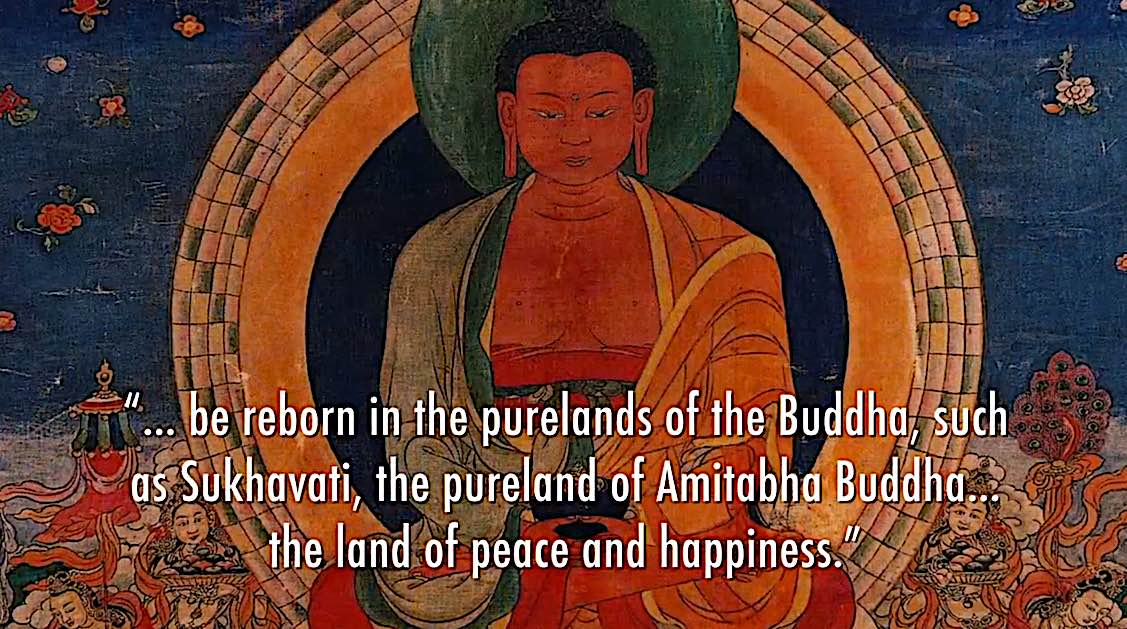
This is why Amitabha Buddha Powa practice is very common now. You also have Powa practice of Chenrezig, Avalokitesvara, Powa practice of Manjushri Buddha, Powa practice of Chittamani Tara, Powa practice of Lama Tsong Khapa, Powa practice of Vajra Yogini, and Powa practice of Heruka Chakrasamvara, and so forth. Different forms of Powa practice.
I’d like to give instructions on how we do it. Usually we do Powa practice as a training because we don’t know when end of the life comes, when death will strike. We don’t know. We never know, right? We have a saying in the dharma, death is definite, imminent, and time of death is indefinite. You go to work, some people never come back. Some people go to sleep, never wake up. Some people go to a holiday or vacation and never come back. You never know. This time we train so that in case something happens then you can pass all your consciousness into Buddhaland.
Or we are going through, slowly, in the old age, dying with old age. Then you can transfer your consciousness to Pureland. That’s the right time, good time, so we train now. Right now. This is very beneficial.
What we do here is you have to receive transmission on Powa from qualified Lama or master and get the mantra of Amitabha Buddha, which I will say to you now: “Om Amitabha Hri,” or in Tibet’s pronunciation we say, “Om Ami Dewa Hri.” Either way is fine. Sanskrit pronunciation is Om Amitabha Hri. Hri is seed syllable of Amitabha Buddha. [When asked, Rinpoche clarified: In this case, a serious student, may practice this more accessible Powa of Amitabha (simplified) — without necessarily having Higher Yoga initiation. This is because this is Amitabha Powa, and Amitabha and his Pureland, are accessable practices to anyone. Rinpoche does ask students to view this as an educational video and — if practiced — to do so seriously, and preferrably under guidance of one’s teacher.]
Now you visualize Amitabha Buddha above your crown, straight above your crown easily, above your crown facing the center. Or you visualize Amitabha Buddha in front of you and say about maybe 10 feet or five feet above you sitting on a lotus and moon cushion. Amitabha is a red one, red colored one. He looks a little bit like Shakyamuni Buddha in a form of bhikkhu or a monk, has a one face, two hands. His both hands are in mudra of meditative equipoise and holding his bowl, begging bowl with a nectar inside and red color, magnificent red color, wearing beautiful saffron robe, red, burgundy robe, and so forth. His face is so peaceful and so beautiful. His entire body is the nature of light and energy, and also light shining behind his body. His physical body is marked with 32 major marks of the Buddha and 80 minor marks of the Buddha.
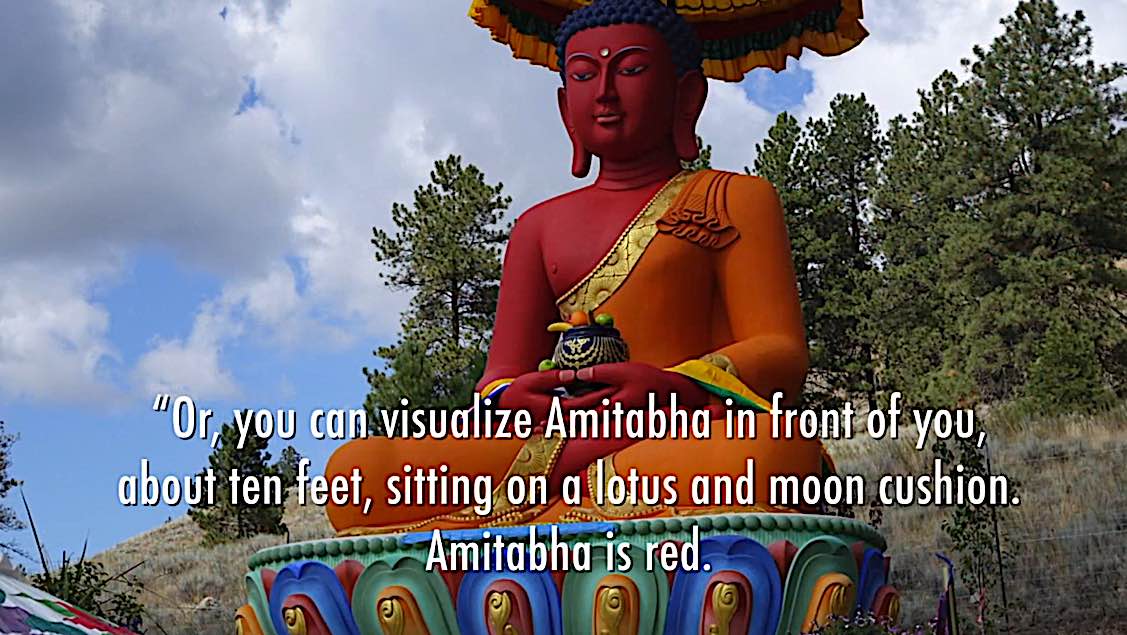
When we visualize we don’t need to go to all of the details. It’s not possible to know. That’s not necessary. I’m just saying the qualities of the Buddha’s holy body.
Visualize Amitabha Buddha infront of you slightly higher up or above you. Okay? Then you pray to Amitabha Buddha, “Oh, Amitabha Buddha… You are the Buddha of Infinite Light. You are unique Buddha for transferring the consciousness of person like myself. At this time I need to heal my mind, overcome my fear, anxiety and not knowing what happen during the day of an after death.” (Right? Death can come anytime.) “You are the Buddha of Infinite Light. Please help me and bless me be able to do the Powa practice and transfer my consciousness into the light of your heart.” Okay. So you visualize Amitabha Buddha there in front of you or above you.
Then you say the mantra of Om Amitabha Hri or Om Ami Dewa Hri in Tibetan. “Om Amitabha Hri” or “Om Ami Dewa Hri,” you say 108 times, minimum or more. You go do sadhana now of Amitabha Buddha. There different versions, the longer one, medium one, and short one. Either way is fine.

Now when you do the Powa practice, first, you have to visualize channels inside of your body. Inside your body, visualize, first, as hollow. Okay. You imagine your body is more or less hollow and you do not have all these material substances inside of your body, heart and liver, and so on and so forth. It’s more or less hollow. Visualize central channel. Central channel. “Tsa uma” in Tibetan word. “Tsa” means channel and “uma” is central channel, uma. Sanskrit word is avadhuti.
Central channel running through the center of your body, slightly close to the backside. Outside is blue, inside is red, slightly. Central channel is an energy channel. Visualize the thickness of either thin bamboo arrow or drinking straw. Maybe [that’s easier] nowadays — a drinking straw, everybody knows. Visualize thickness of drinking straw, outside is blue, inside is red. At this time visualize the bottom of the central channel is closed. When you do Powa practice it has to be closed. The bottom of the central channel is situated four-finger widths below your belly button and that is closed. Okay.
The upward is part is getting a little wider as it pass through the throat chakra up to the crown wider and wider. It’s almost like the bottom of clarinet or certain musical instrument like a trumpet, a little wider. It opens right above your skull, right here. It opens and hollow. Of course, visualize the central channel in the form of light. Okay.
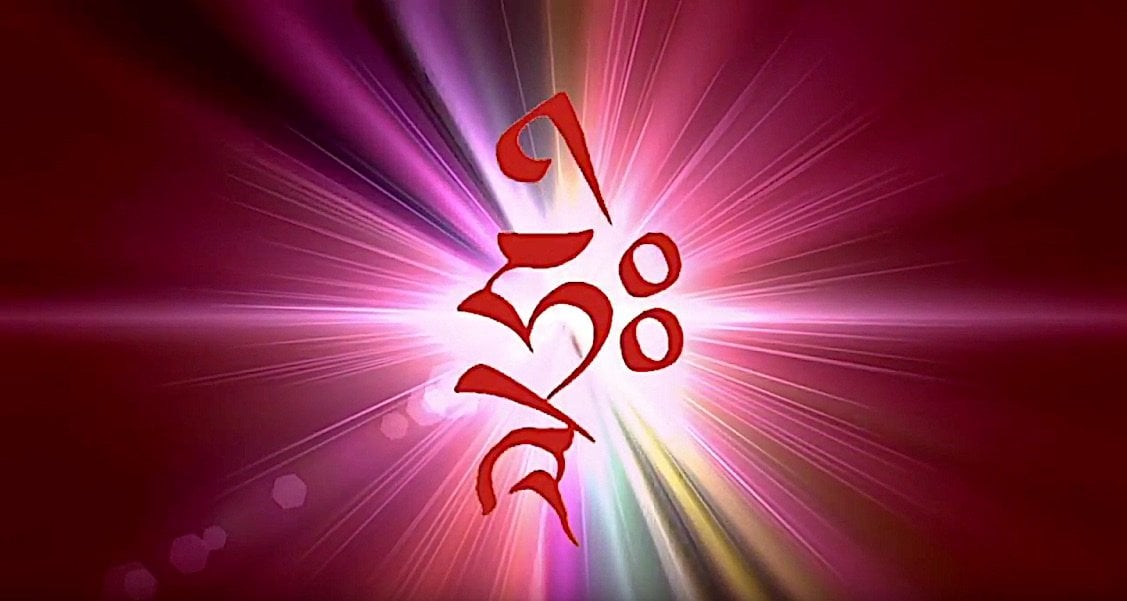
Then you visualize Hri syllable, Hri, at the heart level, here, between your breast inside the central channel and a small moon disc. Okay? In the middle of the moon disc you visualize red Hri syllable, red color. Hri syllable. Hri is like in English, H-R-I, or Hri. Hri. Small one, size of mustard seed. “Yungs kar” in Tibetan word. Mustard seed, size of mustard size. A very beautiful bright red syllable. Imagine this is your intrinsic nature of your mind. Your real mind. Here. [Points at centre of chest.]
Okay. Now your mind is here. Your mind is the one, the subject, seeing the hollow channel, central channel. You see Amitabha is up there. Then your mind is … You don’t visualize or imagine, your mind is here or somewhere else, looking from some other directions, from some other location looking inside. Now, right here looking here, this way.
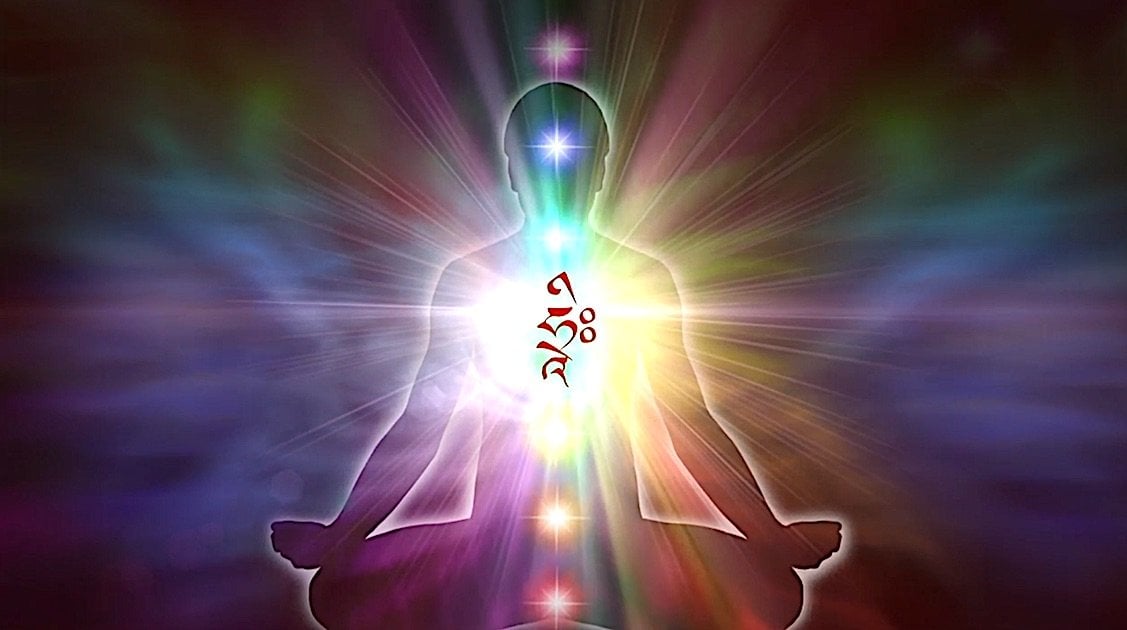
Then you wish to transfer your consciousness. You wish to eject your consciousness to the heart of Amitabha Buddha to the Light, Infinite Light. You have to say to yourself, “Now I am done, basically, in this life and I’m ready to go. I have no hesitation to go. No fear to go. I have no clinging, no attachment, and I don’t need anything. I don’t want anything. I renounce. Okay. I want to experience divine light, clear light, and Infinite Light.”
Also, not only that, “I would like to reach enlightenment, Buddhahood. I would like to reach Pureland of the Buddha, not just for my own benefit, but the benefit of all sentient beings. If you reach Pureland of the Buddha, then soon, soon, very soon you are going to become enlightened Buddha. It doesn’t take very long when you reach Pureland. This is one way and fast way, quicker way to become enlightened. Okay. We call this Powa, in Tibetan tradition, that Powa practice is actually higher tantric practice. Part of what we call completion state practice in a higher tantric.
You think, I would like to reach enlightenment for all sentient beings. Once I become enlightened then I could return to the world, reincarnate other Bodhisattva, I can help serve all sentient beings for that reason. Not just I am trying to escape from sorrow, from this world. Okay, so that’s the motivation.
Then, you kind of, how should I say it, you are eager to eject your consciousness and transfer your consciousness to Amitabha Buddha’s heart. After that, you imagine Amitabha Buddha is asking you, calling you, saying, “Come up.” Amitabha Buddha is saying to you, “Oh, my son or daughter, you come up now to the pureland. It is a good time for you.” If you come up, if you can reach, you will be very happy, you will experience tremendous peace, happiness, joy, and experience light, and you experience Bodhisattva, bhumis, state of Bodhisattva and you’re going to be enlightened. Therefore, you must come up. Your Amitabha Buddha is calling you.”
Practical meditation instructions
Now the practical meditation. After that you sit straight. You are sitting straight anyways. Then you do a little bit breathing. You breathe in through both the nostrils. Imagine the prana [vital life force, Chi, lung] goes down. Then you imagine prana coming up from below, from your rectum coming up, prana coming up and coming up slowly towards the heart. Then you say the syllable “Hick.” When you say first “Hick”, the consciousness are the red seed syllable Hri, moves up from the heart to the throat.
Then you say again, “Hick.” It moves up to the crown. Then you say once more time, “Hick.” It goes straight up, go to the heart of Amitabha Buddha, so fast like a shooting star, reaching the heart of Amitabha Buddha. Your consciousness merges, dissolved into the heart of Amitabha, you experience the clear light, become oneness with Amitabha’s divine light, enlightened mind, become oneness and indivisible. Indivisibleness. Imagine you reach pureland of Amitabha.
Okay. That’s the practice. This is how you do at the very end of the life. You know that you are going to leave this body. Basically, you are dying, right? And you don’t come back. You don’t have wish to come back, right? For now. But as an everyday practice, daily practice, you don’t just leave it there because you’re still here, you want to live. You want to continue your life practice, I mean, practice dharma and function your everyday life. So, you come back.
What you do is after you eject consciousness, when you say, “Hick,” then a few seconds you say, “Ka.” Okay. When you say “Ka,” the consciousness as the Hri letter descending, back to the heart. When you say “Hick,” ascending. When you say “Ka,” descending. So “Hick,” “Ka.” “Hick,” “Ka.” “Hick,” “Ka.” Not so fast, but slowly, slowly. Do it for seven times. For now that’s good enough for each session, seven times.
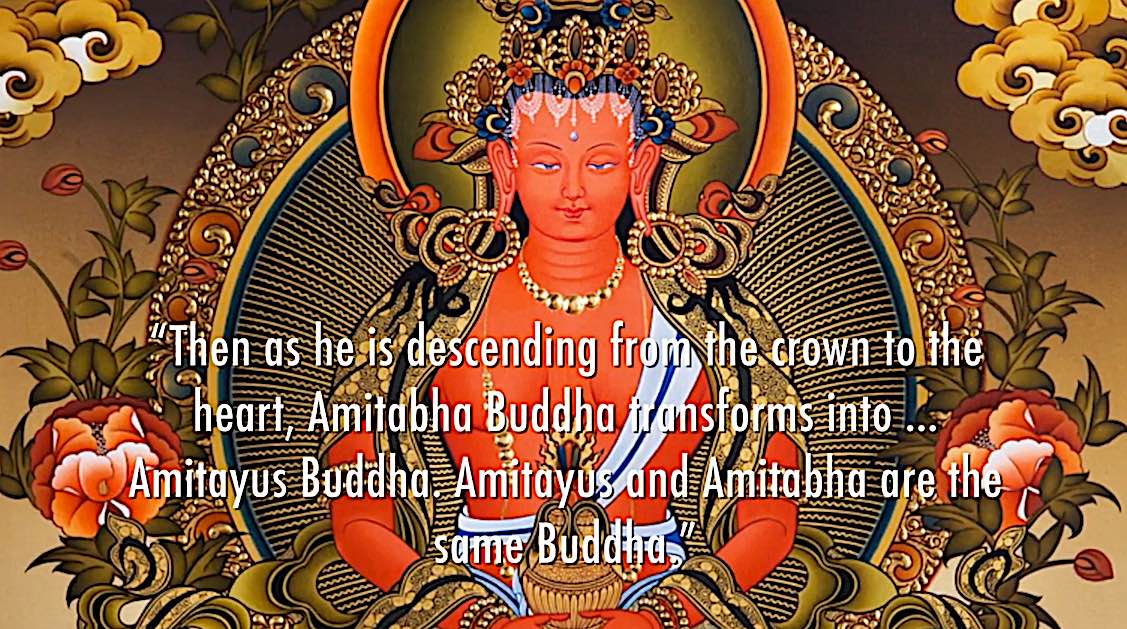
Then after that, closure. Then you imagine the Amitabha Buddha that you visualized above your crown and descending down. He descends down on your crown. Then as he’s descending from crown to the heart, Amitabha Buddha transforms into slightly different Buddha called Amitayus. Amitabha and Amitayus are the same Buddha. Amitabha Buddha looks like a bhikkhu; he’s a bhikkhu. Amitayus is like a prince. He has long hair, topknot, beautiful ornaments, earrings and necklaces, and so on, and wearing beautiful silk dresses, not a monk dress and robe, silk dresses. He’s holding long life vase, instead of begging bowl with nectar, long life vase.
Then as Amitabha descends from the crown at the heart, the Amitabha Buddha transforms into Amitayus. Amitayus is also red one, sitting cross-legged. It’s actually very easy to transform, visualize. Then Amitayus, Tibetan word is “tse pagme.” “Tse” means life, “pagme” is long life. Amitayus is descending from the crown down to your heart. Here. [Points to middle of chest.]
Then Amitayus Buddha stays at your heart on the moon disc and always there and more light, red light shining from Amitayus Buddha, light shining, light going inside of your body. Your entire body is nourished with the blessing of Amitayus and the light of Amitayus. You imagine also your life force is increased. You have a long life, good health. Your long life, good health is increasing. This is how you end and envision the closure in every life practice, except at the time of death, end of your life.
This is a brief explanation on Powa of Amitabha. Mantra for Amitabha is Om Ami Dewa Hri. Mantra for Amitayus is Om amarani Zewanteye Soha. In Tibet, we say “Om amarani dziwantiye soha.” Sanskrit term is “Om amarani jiwantiye svaha.” Om amarani jiwantiye svaha. Tibet way of saying is “Om amarani dziwantiye soha.”
MANTRA of Amitayus:
OM A MA RA NI DZI WAN TI YE SOHA
Okay. Thank you very much.
About H.E. Zasep Rinpoche
Venerable Acharya Zasep Tulku Rinpoche is Spiritual Director of Gaden for the West, with meditation centers in Canada, Australia and the United States. Rinpoche is popularly known for his approachable teaching style, strong humor and teachings based on a long lineage of great lamas. His own gurus included the most celebrated of Gelug teachers: His Holiness Kyabje Trijang Rinpoche, His Holiness Kyabje Ling Rinpoche, Venerable Geshe Thupten Wanggyel, His Holiness Kyabje Zong Rinpoche, Venerable Lati Rinpoche, Venerable Tara Tulku Rinpoche and Venerable Khalkha Jetsun Dampa Rinpoche. Rinpoche is spiritual director of many temples, meditation centres and retreat centres in Australia, the United States and Canada. He was first invited to teach in Australia by Lama Thubten Yeshe in 1976.
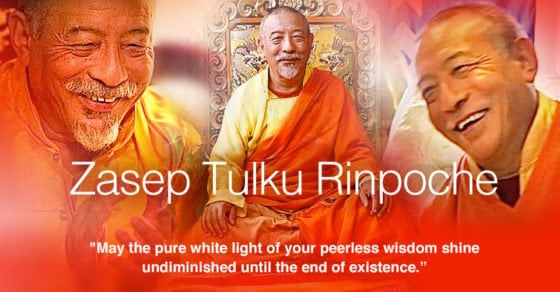
H.E. Zasep Tulku Rinpoche with a line from his “long life prayer” which was composed by his teacher HH Kyabje Trijang Rinpoche.
About Yoko Dharma

Yoko Dharma
From her website:
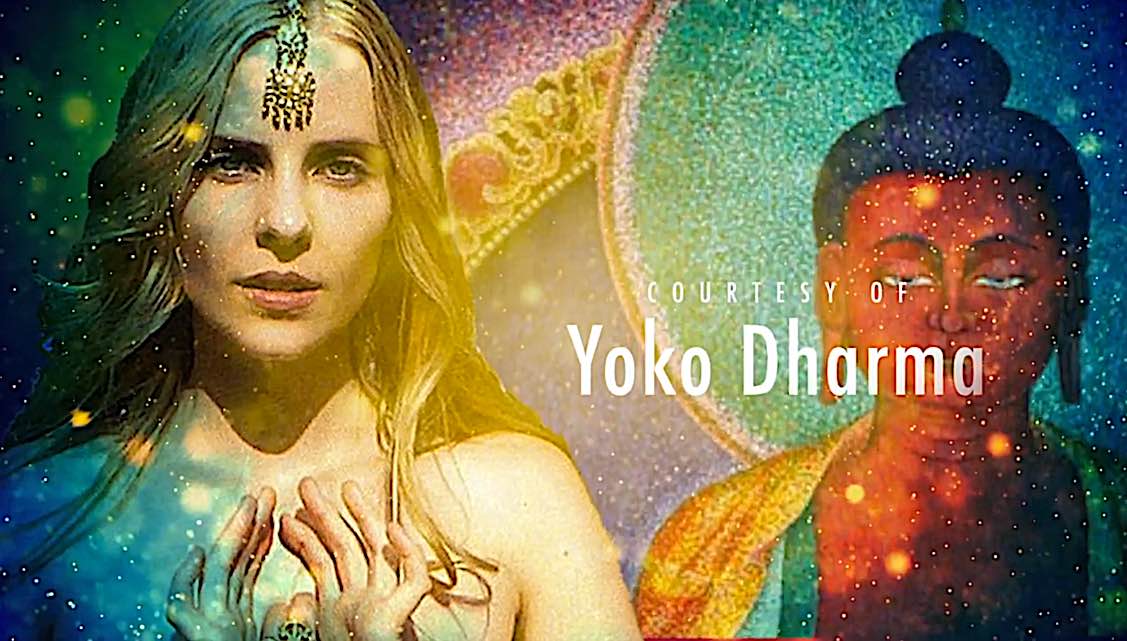
Latest Features
Please support the "Spread the Dharma" mission as one of our heroic Dharma Supporting Members, or with a one-time donation.
Please Help Support the “Spread the Dharma” Mission!
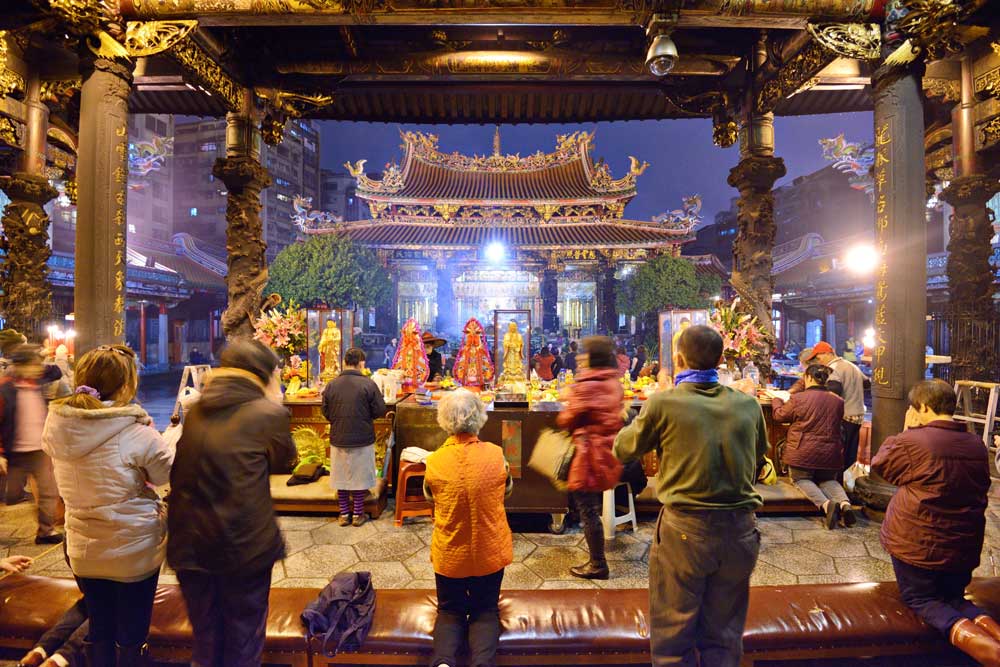
Be a part of the noble mission as a supporting member or a patron, or a volunteer contributor of content.
The power of Dharma to help sentient beings, in part, lies in ensuring access to Buddha’s precious Dharma — the mission of Buddha Weekly. We can’t do it without you!
A non-profit association since 2007, Buddha Weekly published many feature articles, videos, and, podcasts. Please consider supporting the mission to preserve and “Spread the Dharma." Your support as either a patron or a supporting member helps defray the high costs of producing quality Dharma content. Thank you! Learn more here, or become one of our super karma heroes on Patreon.
Lee Kane
Author | Buddha Weekly
Lee Kane is the editor of Buddha Weekly, since 2007. His main focuses as a writer are mindfulness techniques, meditation, Dharma and Sutra commentaries, Buddhist practices, international perspectives and traditions, Vajrayana, Mahayana, Zen. He also covers various events.
Lee also contributes as a writer to various other online magazines and blogs.

